True Or False: It Is Believed That Animals Evolved From Archaea?
Introduction to Animal Multifariousness
140 The Evolutionary History of the Animal Kingdom
Learning Objectives
By the end of this section, yous will be able to do the following:
- Describe the features that characterized the primeval animals and approximately when they appeared on world
- Explain the significance of the Cambrian period for animate being evolution and the changes in animal diversity that took place during that fourth dimension
- Describe some of the unresolved questions surrounding the Cambrian explosion
- Discuss the implications of mass fauna extinctions that have occurred in evolutionary history
Many questions regarding the origins and evolutionary history of the animal kingdom continue to exist researched and debated, as new fossil and molecular evidence change prevailing theories. Some of these questions include the post-obit: How long take animals existed on Earth? What were the earliest members of the fauna kingdom, and what organism was their common antecedent? While animal diversity increased during the Cambrian period of the Paleozoic era, 530 meg years ago, modern fossil evidence suggests that primitive animal species existed much earlier.
Pre-Cambrian Fauna Life
The time before the Cambrian flow is known as the Ediacaran Period (from about 635 1000000 years ago to 543 million years agone), the final menses of the belatedly Proterozoic Neoproterozoic Era ((Figure)). Ediacaran fossils were first institute in the Ediacaran hills of Southern Australia. There are no living representatives of these species, which have left impressions that await like those of feathers or coins ((Figure)). It is believed that early animal life, termed Ediacaran biota, evolved from protists at this time.
An evolutionary timeline. (a) Earth'southward history is divided into eons, eras, and periods. Note that the Ediacaran period starts in the Proterozoic eon and ends in the Cambrian period of the Phanerozoic eon. (b) Stages on the geological time scale are represented as a screw. (credit: modification of work by USGS)
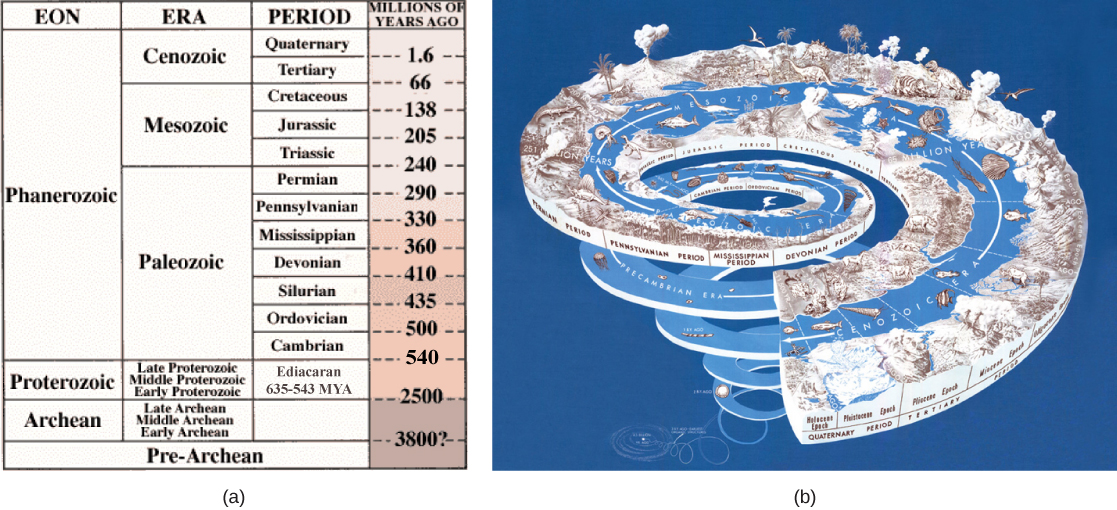
Virtually Ediacaran biota were just a few mm or cm long, merely some of the feather-like forms could reach lengths of over a meter. Recently there has been increasing scientific evidence suggesting that more than varied and complex creature species lived during this time, and probable even before the Ediacaran period.
Fossils believed to correspond the oldest animals with hard body parts were recently discovered in Southward Australia. These sponge-like fossils, named Coronacollina acula, engagement dorsum as far as 560 meg years, and are believed to show the being of hard trunk parts and spicules that extended twenty–40 cm from the thimble-shaped body (estimated about five cm long). Other fossils from the Ediacaran menses are shown in (Effigy)a, b, c.
Ediacaran creature. Fossils of (a) Cyclomedusa (up to 20 cm), (b) Dickinsonia (up to 1.iv m), (and (c) Spriggina (up to 5 cm) date to the Ediacaran menstruation (543-635 MYA). (credit: modification of work by "Smith609"/Wikimedia Commons)
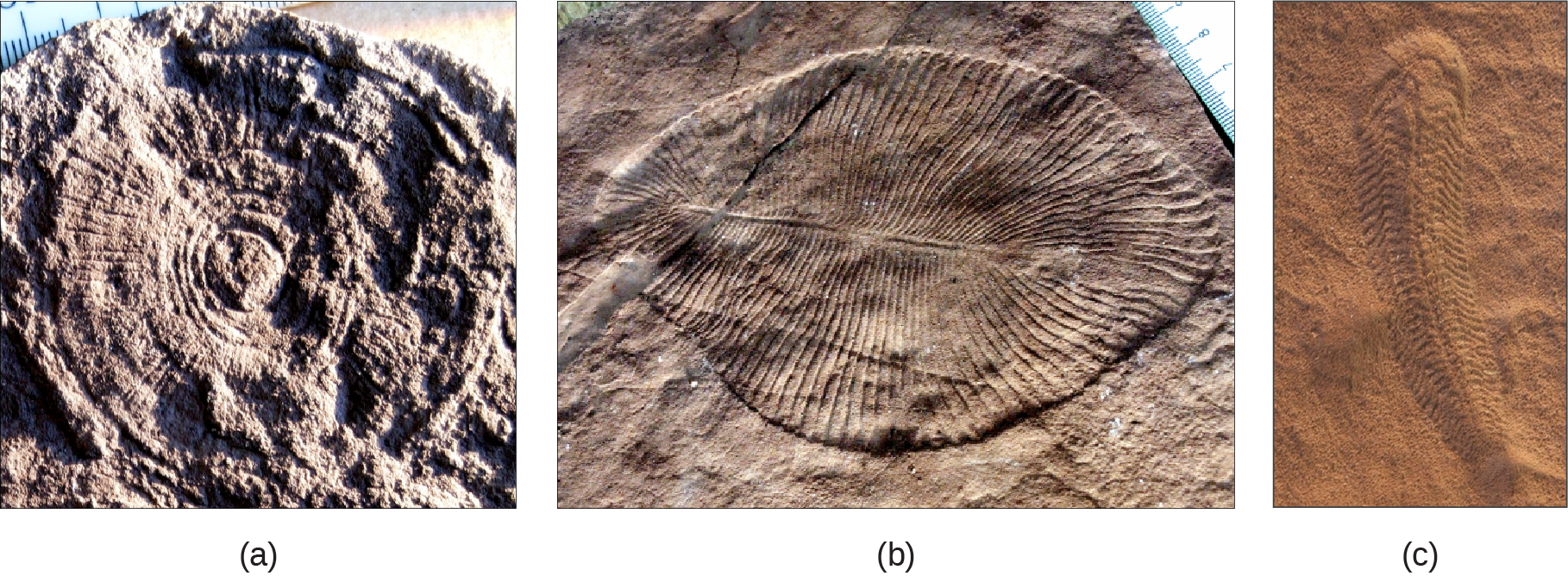
Another recent fossil discovery may represent the earliest beast species ever constitute. While the validity of this claim is even so nether investigation, these primitive fossils appear to exist pocket-size, i-centimeter long, sponge-similar creatures, irregularly shaped and with internal tubes or canals. These aboriginal fossils from Southward Australia date dorsum 650 million years, actually placing the putative creature before the great water ice age extinction effect that marked the transition betwixt the Cryogenian menstruation and the Ediacaran period. Until this discovery, nearly scientists believed that there was no animal life prior to the Ediacaran period. Many scientists now believe that animals may in fact have evolved during the Cryogenian menstruum.
The Cambrian Explosion of Beast Life
If the fossils of the Ediacaran and Cryogenian periods are enigmatic, those of the following Cambrian catamenia are far less so, and include body forms like to those living today. The Cambrian period, occurring between approximately 542–488 million years ago, marks the most rapid evolution of new animal phyla and animal diversity in World'south history. The rapid diversification of animals that appeared during this period, including nearly of the animal phyla in beingness today, is often referred to every bit the Cambrian explosion ((Figure)). Animals resembling echinoderms, mollusks, worms, arthropods, and chordates arose during this period. What may have been a height predator of this period was an arthropod-like brute named Anomalocaris, over a meter long, with chemical compound optics and spiky tentacles. Patently, all these Cambrian animals already exhibited complex structures, so their ancestors must have existed much earlier.
Fauna of the Burgess Shale. An artist's rendition depicts some organisms from the Cambrian flow. Anomalocaris is seen in the upper left quadrant of the film.

I of the nearly dominant species during the Cambrian period was the trilobite, an arthropod that was among the commencement animals to exhibit a sense of vision ((Figure)a,b,c,d). Trilobites were somewhat like to modern horseshoe crabs. Thousands of different species have been identified in fossil sediments of the Cambrian period; non a single species survives today.
Trilobites. These fossils (a–d) vest to trilobites, extinct arthropods that appeared in the early Cambrian flow, 525 1000000 years ago, and disappeared from the fossil record during a mass extinction at the stop of the Permian menstruum, about 250 million years agone.
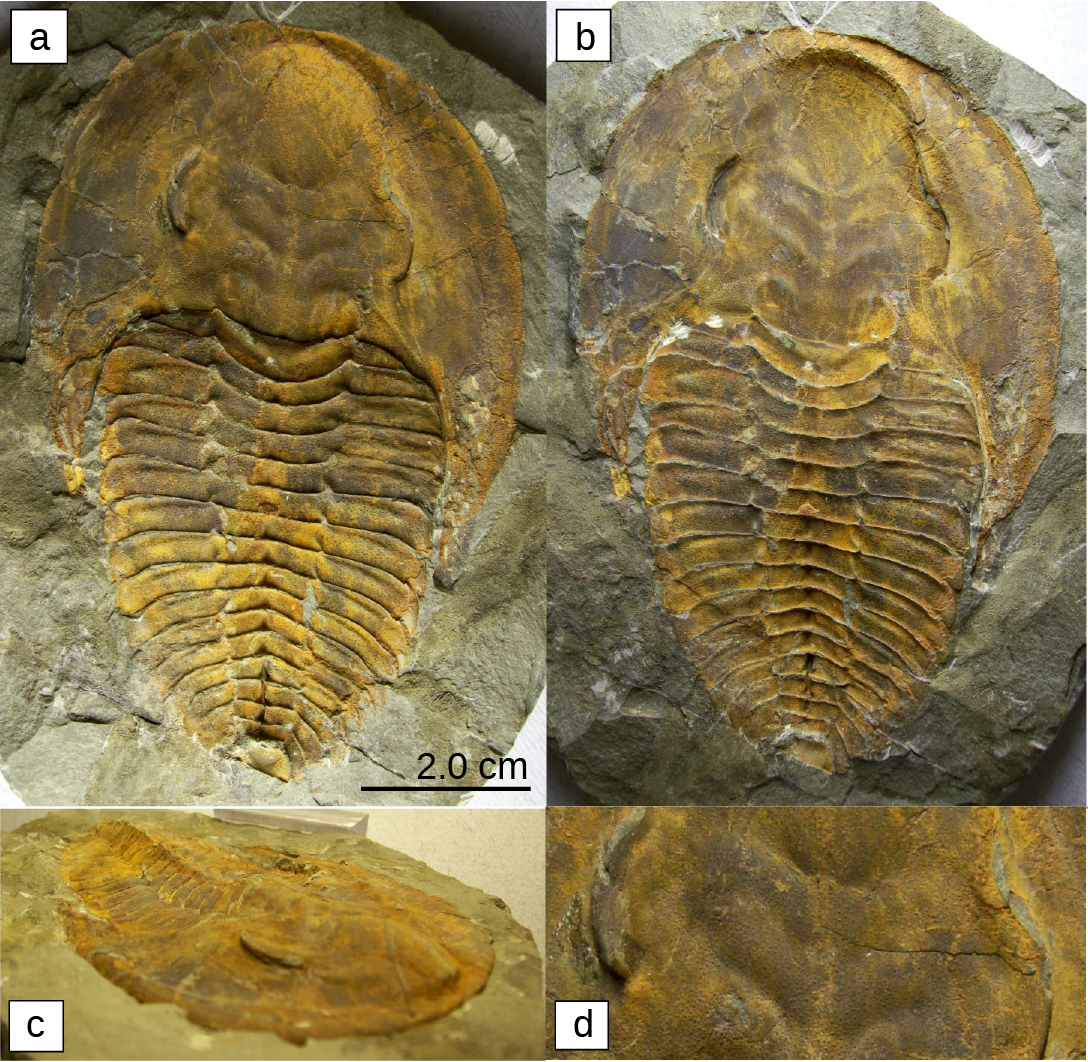
The cause of the Cambrian explosion is all the same debated, and in fact, it may be that a number of interacting causes ushered in this incredible explosion of animal diversity. For this reason, at that place are a number of hypotheses that effort to answer this question. Environmental changes may take created a more suitable surround for beast life. Examples of these changes include rising atmospheric oxygen levels ((Effigy)) and large increases in oceanic calcium concentrations that preceded the Cambrian period. Some scientists believe that an expansive, continental shelf with numerous shallow lagoons or pools provided the necessary living space for larger numbers of different types of animals to coexist. There is also support for hypotheses that debate that ecological relationships between species, such equally changes in the food web, competition for nutrient and space, and predator-casualty relationships, were primed to promote a sudden massive coevolution of species. Yet other hypotheses claim genetic and developmental reasons for the Cambrian explosion. The morphological flexibility and complexity of animal development afforded by the development of Hox command genes may accept provided the necessary opportunities for increases in possible animal morphologies at the fourth dimension of the Cambrian menses. Hypotheses that attempt to explain why the Cambrian explosion happened must be able to provide valid reasons for the massive animal diversification, equally well every bit explain why it happened when it did. In that location is evidence that both supports and refutes each of the hypotheses described in a higher place, and the answer may very well be a combination of these and other theories.
Atmospheric oxygen over time. The oxygen concentration in Earth's atmosphere rose sharply around 300 one thousand thousand years agone.
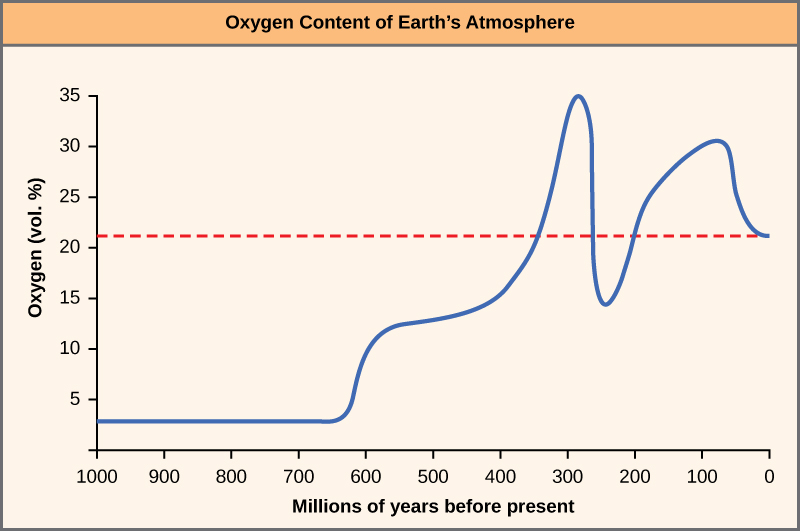
Nonetheless, unresolved questions nigh the creature diversification that took place during the Cambrian period remain. For example, we do not sympathize how the evolution of and then many species occurred in such a short period of fourth dimension. Was there really an "explosion" of life at this particular fourth dimension? Some scientists question the validity of this idea, because there is increasing evidence to advise that more animal life existed prior to the Cambrian period and that other similar species' so-called explosions (or radiations) occurred later in history as well. Furthermore, the vast diversification of animal species that appears to have begun during the Cambrian period connected well into the following Ordovician catamenia. Despite some of these arguments, near scientists concur that the Cambrian menses marked a time of impressively rapid animate being evolution and diversification of body forms that is unmatched for any other time flow.
Link to Learning
View an animation of what body of water life may accept been like during the Cambrian explosion.
Post-Cambrian Evolution and Mass Extinctions
The periods that followed the Cambrian during the Paleozoic Era are marked by further animate being evolution and the emergence of many new orders, families, and species. As animal phyla continued to diversify, new species adjusted to new ecological niches. During the Ordovician period, which followed the Cambrian menstruum, plant life first appeared on state. This change allowed formerly aquatic animal species to invade land, feeding direct on plants or decomposable vegetation. Continual changes in temperature and moisture throughout the remainder of the Paleozoic Era due to continental plate movements encouraged the development of new adaptations to terrestrial existence in animals, such as limbed appendages in amphibians and epidermal scales in reptiles.
Changes in the surroundings often create new niches (diversified living spaces) that invite rapid speciation and increased diversity. On the other paw, cataclysmic events, such as volcanic eruptions and meteor strikes that obliterate life, can event in devastating losses of multifariousness to some clades, yet provide new opportunities for others to "fill in the gaps" and speciate. Such periods of mass extinction ((Figure)) have occurred repeatedly in the evolutionary record of life, erasing some genetic lines while creating room for others to evolve into the empty niches left behind. The terminate of the Permian period (and the Paleozoic Era) was marked past the largest mass extinction event in Earth's history, a loss of an estimated 95 percent of the extant species at that time. Some of the dominant phyla in the world'south oceans, such as the trilobites, disappeared completely. On state, the disappearance of some dominant species of Permian reptiles made it possible for a new line of reptiles to emerge, the dinosaurs. The warm and stable climatic atmospheric condition of the ensuing Mesozoic Era promoted an explosive diversification of dinosaurs into every conceivable niche in country, air, and water. Plants, too, radiated into new landscapes and empty niches, creating complex communities of producers and consumers, some of which became very large on the abundant food available.
Some other mass extinction event occurred at the terminate of the Cretaceous period, bringing the Mesozoic Era to an end. Skies darkened and temperatures fell after a large meteor impact and tons of volcanic ash ejected into the temper blocked incoming sunlight. Plants died, herbivores and carnivores starved, and the dinosaurs ceded their dominance of the landscape to the more than warm-blooded mammals. In the following Cenozoic Era, mammals radiated into terrestrial and aquatic niches once occupied by dinosaurs, and birds—the warm-blooded direct descendants of 1 line of the ruling reptiles—became aerial specialists. The appearance and dominance of flowering plants in the Cenozoic Era created new niches for pollinating insects, likewise as for birds and mammals. Changes in fauna species diversity during the tardily Cretaceous and early Cenozoic were also promoted by a dramatic shift in Globe'south geography, every bit continental plates slid over the crust into their current positions, leaving some animal groups isolated on islands and continents, or separated by mountain ranges or inland seas from other competitors. Early in the Cenozoic, new ecosystems appeared, with the evolution of grasses and coral reefs. Late in the Cenozoic, farther extinctions followed past speciation occurred during ice ages that covered loftier latitudes with water ice and so retreated, leaving new open spaces for colonization.
Link to Learning
Watch the following video to learn more nigh the mass extinctions.
Extinctions. Mass extinctions have occurred repeatedly over geological time.
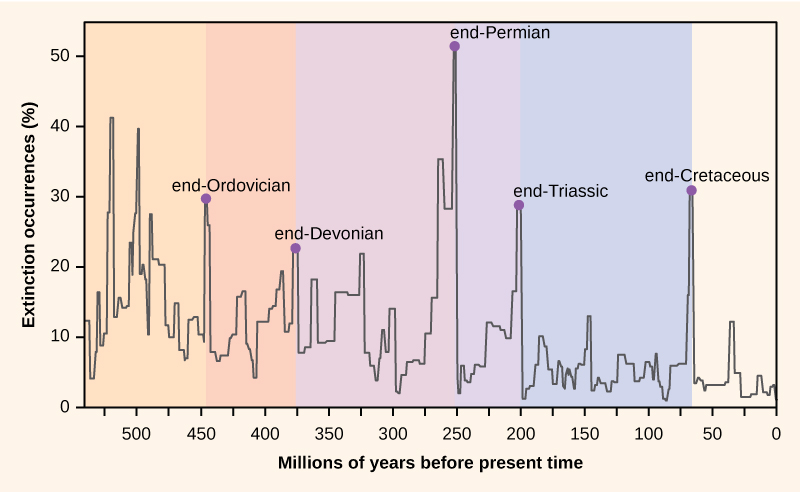
Career Connection
PaleontologistNatural history museums incorporate the fossils of extinct animals as well as information virtually how these animals evolved, lived, and died. Paleontologists are scientists who study prehistoric life. They use fossils to observe and explain how life evolved on Earth and how species interacted with each other and with the environment. A paleontologist needs to exist knowledgeable in mathematics, biology, ecology, chemistry, geology, and many other scientific disciplines. A paleontologist's piece of work may involve field studies: searching for and studying fossils. In addition to digging for and finding fossils, paleontologists also prepare fossils for farther study and assay. Although dinosaurs are probably the outset animals that come to mind when thinking almost ancient life, paleontologists study a diversity of life forms, from plants, fungi and invertebrates to the vertebrate fishes, amphibians, reptiles, birds and mammals.
An undergraduate degree in globe scientific discipline or biological science is a good place to start toward the career path of becoming a paleontologist. Most oft, a graduate degree is necessary. Additionally, work feel in a museum or in a paleontology lab is useful.
Section Summary
The most rapid documented diversification and development of animal species in all of history occurred during the Cambrian period of the Paleozoic Era, a miracle known every bit the Cambrian explosion. Until recently, scientists believed that there were only very few tiny and simplistic animal species in existence before this menses. However, recent fossil discoveries have revealed that additional, larger, and more complex animals existed during the Ediacaran period, and even possibly earlier, during the Cryogenian period. However, the Cambrian catamenia undoubtedly witnessed the emergence of the majority of animal phyla that we know today, although many questions remain unresolved virtually this historical miracle.
The remainder of the Paleozoic Era is marked past the growing advent of new classes, families, and species, and the early on colonization of state past sure marine animals and semiaquatic arthropods, both freshwater and marine. The evolutionary history of animals is too marked past numerous major extinction events, each of which wiped out a majority of extant species. Some species of near beast phyla survived these extinctions, assuasive the phyla to persist and continue to evolve into species that we see today.
Review Questions
Which of the following periods is the primeval during which animals may accept appeared?
- Ordovician period
- Cambrian menstruation
- Ediacaran flow
- Cryogenian menses
D
What type of data is primarily used to make up one's mind the being and appearance of early on animate being species?
- molecular data
- fossil data
- morphological data
- embryological development data
B
The fourth dimension between 542–488 meg years agone marks which menses?
- Cambrian period
- Silurian period
- Ediacaran period
- Devonian period
A
Until recent discoveries suggested otherwise, animals existing earlier the Cambrian period were believed to be:
- minor and ocean-abode
- small and nonmotile
- small and soft-bodied
- small and radially symmetrical or asymmetrical
C
Found life first appeared on land during which of the following periods?
- Cambrian menses
- Ordovician period
- Silurian menses
- Devonian period
B
Approximately how many mass extinction events occurred throughout the evolutionary history of animals?
- 3
- 4
- 5
- more than 5
D
Critical Thinking Questions
Briefly describe at least two theories that endeavor to explain the crusade of the Cambrian explosion.
One theory states that environmental factors led to the Cambrian explosion. For example, the rising in atmospheric oxygen and oceanic calcium levels helped to provide the correct environmental conditions to allow such a rapid evolution of new animal phyla. Some other theory states that ecological factors such equally competitive pressures and predator-prey relationships reached a threshold that supported the rapid brute evolution that took place during the Cambrian period.
How is information technology that most, if not all, of the extant animate being phyla today evolved during the Cambrian menstruum if so many massive extinction events have taken place since then?
It is true that multiple mass extinction events take taken identify since the Cambrian period, when most currently existing animal phyla appeared, and the majority of animal species were ordinarily wiped out during these events. Even so, a small number of animal species representing each phylum were commonly able to survive each extinction event, assuasive the phylum to continue to evolve rather than get altogether extinct.
Glossary
- Cambrian explosion
- time during the Cambrian period (542–488 million years ago) when well-nigh of the animal phyla in existence today evolved
- Cryogenian period
- geologic period (850–630 million years ago) characterized past a very common cold global climate
- Ediacaran flow
- geological period (630–542 million years agone) when the oldest definite multicellular organisms with tissues evolved
- mass extinction
- event or ecology condition that wipes out the majority of species inside a relatively curt geological fourth dimension catamenia
Source: https://opentextbc.ca/biology2eopenstax/chapter/the-evolutionary-history-of-the-animal-kingdom/
Posted by: trudeauthersece.blogspot.com

0 Response to "True Or False: It Is Believed That Animals Evolved From Archaea?"
Post a Comment